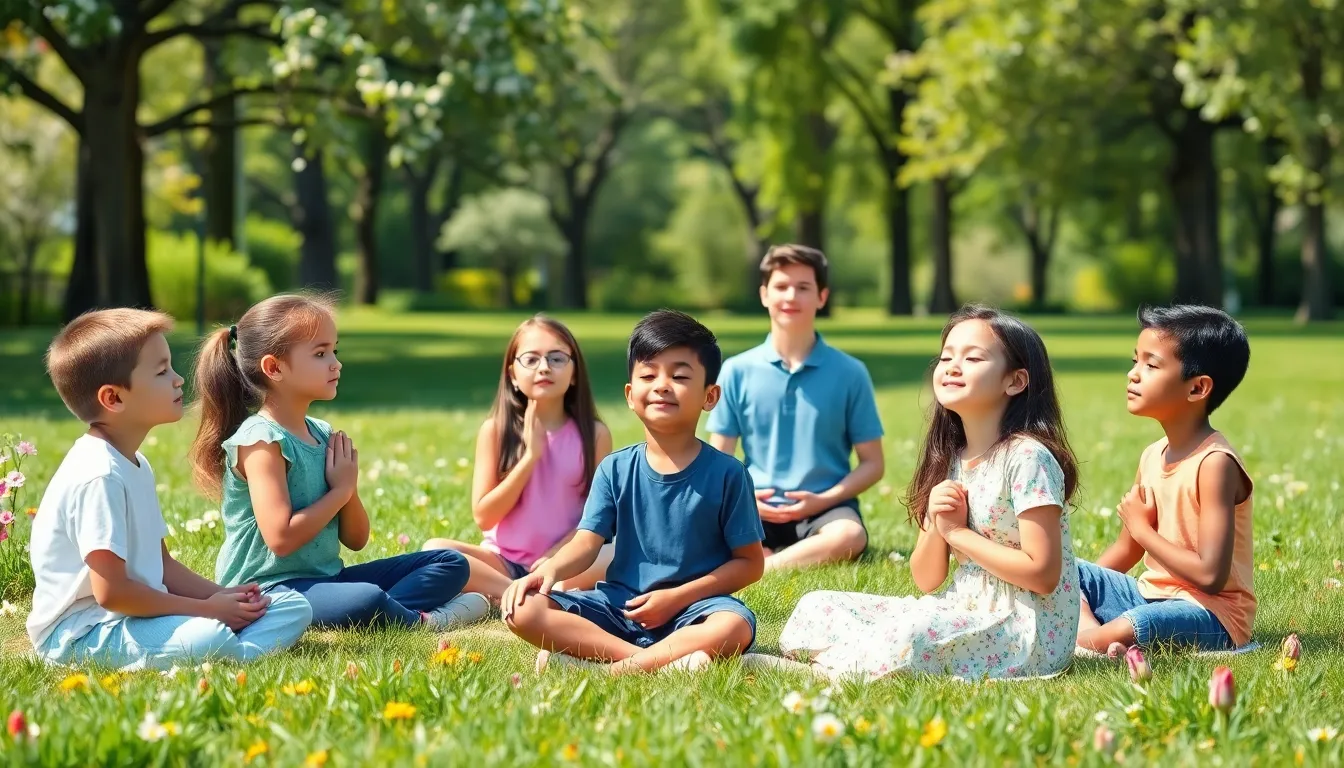In a world buzzing with distractions, teaching kids mindfulness can feel like trying to get a cat to take a bath. Yet, it’s more crucial than ever to help them find their calm amid the chaos. Mindfulness isn’t just a fancy adult term; it’s a superpower that kids can harness to boost focus, reduce stress, and even improve their social skills.
Mindfulness Definition for Kids
Mindfulness refers to the practice of being fully present and aware of one’s thoughts, feelings, and surroundings. Kids can cultivate this skill through simple techniques like focusing on breathing or noticing sensations in their bodies.
What Is Mindfulness?
Mindfulness is the ability to pay attention in a non-judgmental way. It involves recognizing thoughts and feelings without getting overwhelmed by them. Children practice mindfulness by engaging in activities that ground them in the moment. Techniques like guided imagery or mindful breathing help them anchor their awareness. These practices encourage kids to observe their internal experience and external environment, enhancing emotional intelligence.
Importance of Mindfulness for Kids
Mindfulness holds significant benefits for children. It improves focus, fostering better learning and performance in school. Stress reduction occurs as mindfulness helps children manage anxiety and other challenging emotions. Enhanced social interactions follow as kids develop empathy and understanding towards others. Additionally, regular mindfulness practice encourages a positive outlook, benefiting overall mental health. As kids learn to navigate their emotions, they build resilience in the face of stressors.
Mindfulness Definition for Kids

Mindfulness helps kids focus on the present moment. It enables them to recognize their thoughts, feelings, and surroundings.
Simplifying the Concept
Mindfulness means paying attention to what’s happening right now. Kids can practice it by focusing on their breath or noticing how their body feels. They don’t need to change their thoughts or emotions; just observing is enough. Remaining non-judgmental is key, allowing children to understand their experiences without feeling overwhelmed. Simple techniques can make practicing mindfulness fun and engaging for kids, showing them that being present can bring joy.
Key Elements of Mindfulness
Key elements include awareness, attention, and presence. Awareness involves understanding one’s thoughts and feelings. Attention requires focusing on specific sensations or experiences, like the sound of birds or the smell of flowers. Presence emphasizes living in the moment, resisting the urge to think about past worries or future plans. Practicing these elements regularly supports children in developing emotional intelligence and resilience, vital skills for navigating their world. Each element plays a role in helping kids connect more deeply with themselves and their environment.
Benefits of Mindfulness for Children
Mindfulness offers significant advantages for children, supporting their emotional and cognitive development. It enhances various aspects of their lives.
Emotional Regulation
Emotional regulation plays a crucial role in children’s well-being. Mindfulness helps kids identify and understand their emotions. By practicing mindfulness, they learn to pause and respond rather than react impulsively. This skill allows them to handle challenging situations more effectively. Research indicates that children who engage in mindfulness exercises report lower levels of anxiety. They develop greater emotional resilience over time, enabling them to cope with frustrations and setbacks. Mindfulness techniques like deep breathing aid in calming their minds and bodies during stressful moments.
Improved Focus and Attention
Improved focus and attention enhance learning experiences for children. Regular mindfulness practice fosters the ability to concentrate on tasks at hand. Mindful activities train their brains to remain present, minimizing distractions. Children become more adept at tuning into lessons or assignments, leading to better academic performance. Evidence shows that mindfulness contributes to longer attention spans. As kids practice focusing, they develop skills that translate into everyday activities, such as listening during conversations. This heightened awareness boosts their overall engagement and participation in various settings.
How to Teach Mindfulness to Kids
Teaching mindfulness to kids involves engaging activities and simple daily practices that create awareness and presence. Fun, interactive methods capture children’s attention while helping them learn.
Fun Activities and Exercises
Mindfulness can become enjoyable through games and creative exercises. Breathing exercises like “Bubble Breathing” encourage kids to imagine blowing bubbles while they inhale and exhale slowly. Nature walks promote observing surroundings, where kids can notice colors, sounds, and smells. Creative storytelling allows children to visualize and share their feelings. Art activities, such as coloring mandalas, cultivate focus and expression. These activities make mindfulness accessible and engaging for young learners.
Incorporating Mindfulness into Daily Routines
Daily routines present excellent opportunities to integrate mindfulness. Starting each day with a few minutes of mindful breathing sets a calm tone. During meals, encouraging children to savor each bite enhances their awareness of flavors and textures. Bedtime rituals can include yet another brief meditation focused on gratitude, fostering positivity. Transition times, such as getting ready for school, are perfect for practicing deep breaths. Simple moments embedded in everyday life promote a sustained mindfulness practice, allowing kids to grow more aware and connected.
Conclusion
Teaching mindfulness to children equips them with essential tools for navigating a complex world. By fostering awareness and presence they learn to manage their emotions and enhance their focus. Simple practices like mindful breathing and engaging activities make the process enjoyable and effective.
As kids incorporate mindfulness into their daily lives they not only improve their emotional intelligence but also develop resilience. This journey towards mindfulness not only supports their mental health but also enriches their social interactions. By embracing these techniques children can cultivate a sense of calm and joy that lasts a lifetime.

